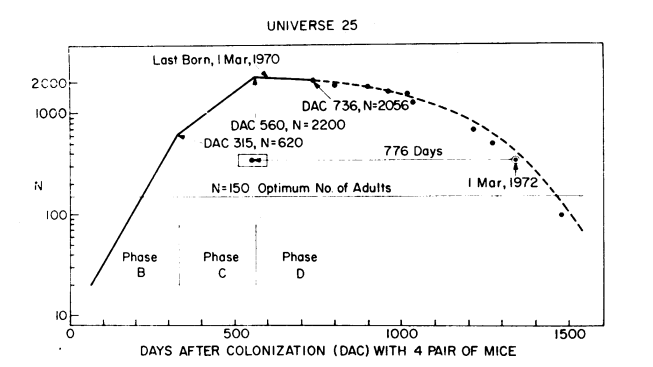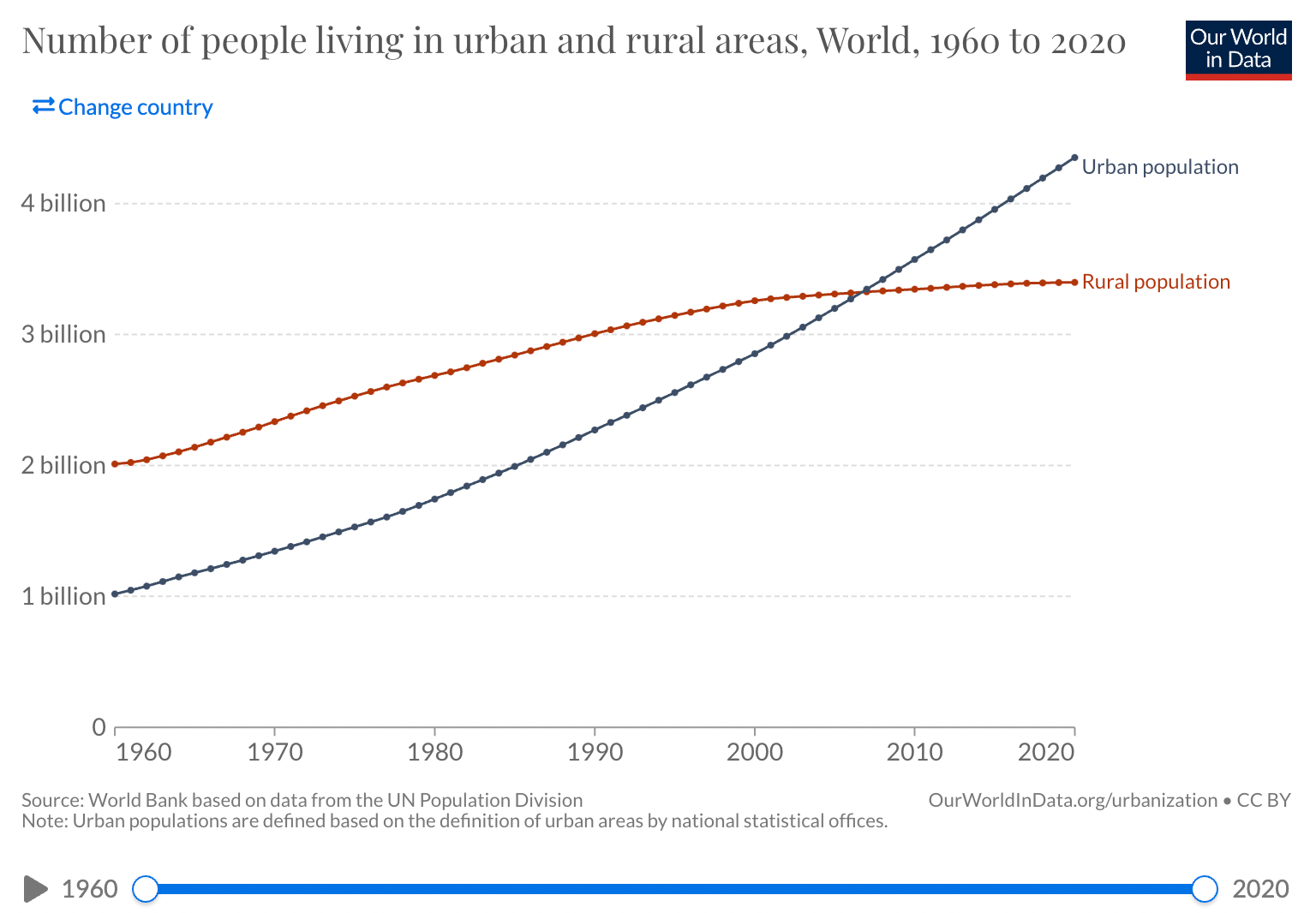Our cities are filled with people more than ever. That trend continues to go on.
More than 50 years ago, one American scientist tries to answer what the consequence would be with rats. His name was John B. Calhoun.
In 1954, Calhoun borrowed a barn from nearby family and modify it to shelter. He prepared every food and enough space to shelter enough mice. He wanted to see how rat population will change with no predators in presence.
His experiment was later known as "rat utopia."
The result of the research is that the rat population indeed continued to multiply. But it stopped well before his prediction. It peaked to 2200 mice on day 560. Mice population dropped slowly after until it reached to mere 27 on day 1588.

He cites the reason of decline in 5 stages:
- Dominant mice loses the ability to protect the territory
- Female rats become aggressive to protect the territory
- Mother rats end up attacking or leaving child rats
- Lack of maternal care, child rats grow up with no ability to handle complex social behaviors such as courtship, maternality, and aggression.
- No fertility
Insight into The Human Scoeity
The research took up the press at the time. People were crazy over overpopulation and running out of food and oil. His proposal caught on fire that even if we escape the material constraint, we will have the biological failure.
If you look at it carefully, however, the cause of decline in one does not apply to us. Whether it is informed by religions or not, most countries present laws that support monogamous marriage framework. We seem to have solved that a single dominant male protecting a large territory.
Ray Kurzaweil, the famous futurist described it; if you take a plane, the world has a plenty of territory. I cant help agree with his sentiment. Most of the world is uninhabited flat land.
Global warming is a pressing issue. But very few of us are worried about not having space to live. Our primary concern is not about physical constraint.
We are not off the hook though. Our behavioral influence of overpopulation is still well intact.
Oversocialized Humans
Our global population will reach its peak in 2050. And then we will have a rapid decline thereafter.
Why did it decline? The curious researcher coined the term behavioral sink to describe the peculiar behavior of overpopulated rats in his subsequent research. Certain characteristics of these are:
- Hyperactivity while everyone is asleep
- Eating only at the presence of others
- Overcrowded at one place for eating, while leaving others untouched (we will come back to this).
Eating and other biological activities were thereby transformed into social activities in which the principal satisfaction was interaction with other rats.
the same pathological "togetherness" tended to disrupt the ordered sequences of activity involved in other vital modes of behavior such as the courting of sex partners, the building of nests and the nursing and care of the young.
The argument went that those rats are way too socialized they forget what they need to really be doing and what's important for them.
So even if we've escaped the territorial concern, the oversocialization as a result of population density may be playing a role in declining fertility.
Urbanization without Progress
Throughout the 20th century, most countries experienced fertility decline. That was independent of economic growth.
UK economy has improved tremendously through from 1950-1980, while it slowed to a pity 1% growth thereafter. In the meanwhile, Vietnam has experienced rapid growth more recently from 1990-2020 at 5%. That's the rate every UK politician could only dream of promising his voter.
But the decline in birth rate has continued in both of these countries throughout the 20th century.
What is consistent in both countries are the rate of urbanization. The basic concept of urban building has not changed since the early 20th century. We build roads for cars, establish metro, bring concrete for apartments, etc.
Currently, the most compelling reason to talk about the decline in fertility is increase in birth mortality, female education, increased social security for the old, etc.
But the decline seems so cross national that those government specific implementation seems too downstream in analysis. The fundamental shift must be in our biology. We are sensing the territorial constraint in our urban environment.
What's In the City?
In Scale, Geoffrey West promotes the efficiency of the city. The bigger the city, the more innovations happen and income grow. Money is what motivates people to enter in the city in the first place. They seek for a better job opportunity. There's no doubt about that.
Geoffrey then goes on to analyze the cellphone usage. And that too increases with the population size of the city. People in the city are way more chitchatting.

That's where we will have the insight from the rat experiment. Geoffrey as a theoretical physics professor assumes conversations happen among the only highly intellectual geniuses. The bias is the curse of academias.
What if it's not only the innovation we are creating inside the city, but we are also creating a bunch of oversocialized rats? Oversocialized rats who are incapable of social function before they hang out too much with their friends and family?
In fact, it is odd intuitively. Why would anyone who lives in the city engage in the phone call, while in theory they should live in the closer proximity to one another. Urban transportation should be better.
What's Wrong With Oversocialization?
One explanation is the generational gap of migrants into the city and local born.
We originally come to the city hoping for better life and income. But those who are born in the city do not know what's out there. It'd be a different stories. As Calhoun defines, the characteristics of oversocialization includes not eating unless others are around and leaving behind large pool of food.
What if people are failing to see the possibility of better life outside their own circles.
This argument is very relevant in the era where housing pricing is skyrocketing. That's despite the fact the opportunity to work remotely is higher than ever. Why aren't more people living in the cheap neighborhood?

I used to think people are making rational decision as into the potential capital gain. The spread if bigger when the housing price rises from $1m to $2m instead of $100,000 to $200,000.
But it seems that most people are simply stuck in the social circle. They make friends with people who grow up in your neighborhood and stays in that circle until they grow old. I'm not denying any of that. But to maintain that social lifestyle, is it worth the servitude of your life? Do you want to go in debt for the next 30 years?
Instead, how hard would it be to spend 2 hours into the city just to see your friends and family with the happy face whose face is not grossed over the stressful never ending debt? The dinners are of course on you with all the money not wasted.
Can We Escape From This Dilemma?
There's no hard limit. Cities have been always with us since the dawn of time. Religions had been developed as the population grew in the cities 2000 years ago, establishing functional maternal rules.
Every time new technology comes, it pushes our biological boundary of how many people cities can accommodate. It was the gasoline cars and concrete buildings in the 20th century.
With today's technology, the upper limit is 20-30 million. Looking at the population decline in NY and LA, that seems to be the current technological limit (though they can probably push further with high rise and metro).
But as the history proves over and over, we will always find a new frontier. Cities, instead of being abandoned, always get renewed with the fresh of new technology that's unforeseeable. It could be 3D printed buildings, vertical lift device, or rapid transportation.

